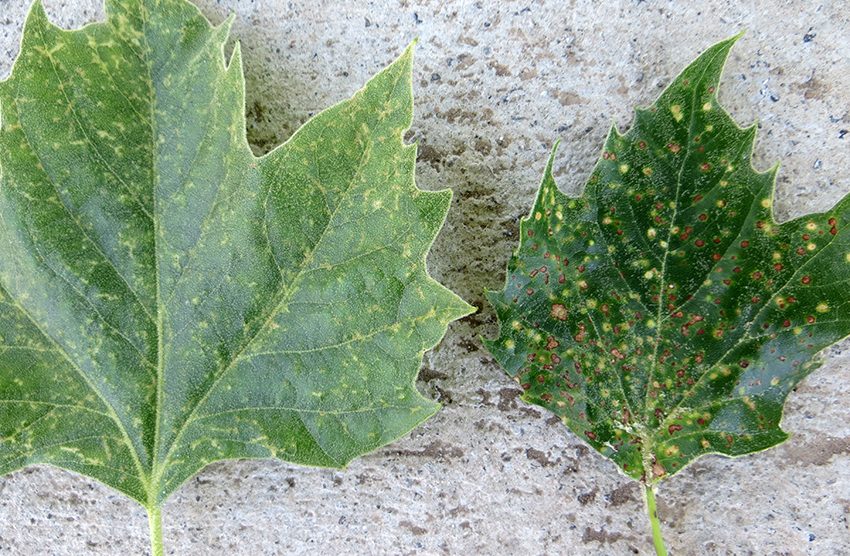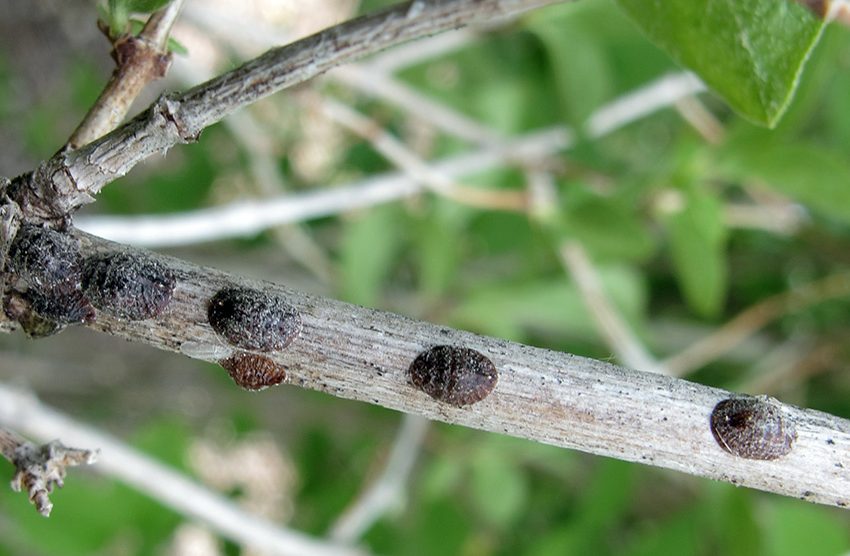In this Issue
DECIDUOUS TREES
- Sycamore (London Planetree) Problems – Anthracnose, Plant Bugs, and Scale
- Scales – Crawler Treatment Dates
- Flowering Plants – Painted Lady caterpillars are feeding on various plants
- Grasshoppers – Nymphs are active now
CONIFERS
- Pine Pitch Moth – Moths actively laying eggs
- European Pine Shoot Moth – Moths laying eggs
DECIDUOUS TREES
Sycamore (London Planetree) Problems – Anthracnose, Plant Bugs, and Scale
Click on image to view captions.
London planetrees in Utah were hit hard with anthracnose this spring, and unfortunately, some trees are experiencing a triple whammy of anthracnose, plant bugs, and sycamore scale (a pest of newer concern).
Sycamore anthracnose is a fungal-caused disease that is highly active in cool, wet springs. But once rains end and temperatures rise above 80F, the pathogen stops activity. Affected foliage is currently dropping and trees are putting out a new flush of foliage. Some trees were hit hard, and should be treated for anthracnose this fall or next spring (see below for treatment options.)
Sycamore plant bug is a native pest of American sycamore that also feeds on London planetree. Its population naturally cycles up and down, and appears to be in an upswing this year, with some trees showing moderate damage. They overwinter as eggs, hatching at budbreak. The life stage that is currently most active now along the Wasatch Front are nymphs, which can be found on the undersides of leaves. They are green with dark eyes and resemble large aphids. They may move rapidly when exposed to light or movement. They will mature to adults in a few weeks, and at the end of the season, adults lay eggs and die.
As plant bugs feed with their piercing-sucking mouthparts, toxins in their saliva cause chlorotic spotting on the foliage. These areas turn brown and fall out of the leaves, gives them a chlorotic and ragged appearance.
To detect them, shake some leaves or a branch over paper or a tray. See below for treatment.
Sycamore scale is a native pest that historically only occurred in California and southwestern U.S. Milder winters have allowed it to survive on London planetree north of these locations. In the last 7 years, it became established in the southern zone of the Wasatch Front, and appears to continue moving north.
This pest overwinters as waxy, cottony egg masses, laid underneath the protective bark scales. Remnants of these egg masses can be seen in the summer as a sign of the scale. Eggs hatch into crawlers in early spring as the tree breaks dormancy, working their way to the newly-expanding foliage. There, the scales settle onto foliage and feed and develop for the summer.
Individual sycamore scales are not visible to the naked eye. They can only be detected by their feeding on the foliage, which causes chlorotic (yellow) spots that eventually turn necrotic (brown). In addition, new summer foliage can be twisted and distorted and eventually leaf drop occurs.
Anthracnose Treatment
For sycamore anthracnose, prune out dead or diseased twigs. For specimen trees, fungicide trunk injections (Arborfos, Arbotect) in spring or fall, for 2 years in a row, have shown to provide long-term protection.
Plant Bug Treatment
The nymphs can be controlled by spraying with ultrafine horticultural oil, insecticidal soap or malathion which are among the compounds registered for control of this pest in Connecticut. Imidacloprid applied as a systemic to be taken up by the roots will also provide season-long control. Consult the label for dosage rates and safety precautions.
Sycamore Scale Treatment
The ideal time to treat for scale is when the buds start to swell and the leaves just begin emerging (budbreak). At this time, the crawlers are hatching from their overwintering sites on the bark and migrating to the foliage, so they are exposed. The University of California-Davis entomologists tested multiple insecticides, and found that a spray of 2-3% horticultural oil was the safest and most effective. At this spray timing, the oil will be able to penetrate through the entire tree and drip onto the bark to reach any unhatched eggs.
The efficacy of a soil- or tree-injected insecticide such as imidacloprid or dinotefuran is still unknown. A few homeowners and landscape companies have tried imidacloprid, and we are currently evaluating the results.
Scale Crawler Treatment Dates
Several scale species have similar life cycles in that their eggs are hatching now or in the next several weeks. Please see the pictures below for information about the scale and when the crawlers are active in the Wasatch Front region (add one week for cooler sites).
Crawlers can be killed with horticultural oil or insecticidal soap. Commercial applicators can use a wide variety of products, including pyrethroids or insect growth regulators.
(Not shown below is euonymus scale, where peak crawler activity is happening now along the Wasatch Front area.)
Click on image to view captions and dates of crawler activity for Wasatch Front area.
Painted Lady Caterpillars

A large migration of painted lady butterflies was reported from California to Utah and Colorado earlier this spring. Currently in northern Utah, late-stage larvae are now visible feeding on weeds and herbaceous plants. In some areas, they are causing economic damage.
Painted lady butterflies spend the winter in the southern southwest deserts, and migrate north each spring and summer. According to University of California-Davis entomologists, their numbers explode in years with high rainfall that results in dense desert wildflowers. Before 2019, the last most notable high migration and high rainfall there was 2005.

Colorado entomologists reports that the last mass migration there was 2017. Butterflies are also commonly seen in late summer, making their migratory trek back to their winter breeding grounds.
UC Davis also reports that the following plants and plant families are hosts:
- Malvaceae (mallows)
- Boraginaceae (notably comfrey and borage)
- Asteraceae (asters)
- sunflower
- Fabaceae (legumes, especially lupines, but not alfalfa or close relatives)
- Verbenaceae (verbenas)
- Plantaginaceae (large group of flowering plants that includes penstemon, snapdragons, many wildflowers, and many ornamental annuals)
- Scrophulariaceae (figworts and relatives)
- Solanaceae (tomatoes and relatives) are not hosts
Check out this fact sheet by entomologists at Colorado State University.
Grasshoppers

Grasshoppers are hatching by the hundreds now in gardens, farms, and rangeland. It is important to manage them while they are still in the nymphal stage rather than waiting. Also, treating as large an area as possible is most effective.
Grasshoppers have voracious appetites and feed on just about everything, from grasses to ornamental plants to vegetables and fruits. Their chewing mouthparts tear away plant tissue, resulting in holes or complete defoliation.
Treatment – Organic
- Nosema locustae is a pathogen of grasshoppers, available embedded in a bran carrier and sold as Nolo Bait. It is normally sprinkled around the garden area, but degrades quickly when wet. Therefore, some growers will put the bait in protective areas protected from water, like sections of PVC pipe.
- There are a few other organic spray options, including products that contain pyrethrin or azadirachtin (BioNeem, Aza-Direct, AzaGuard, etc.), but these must be re-applied, and the grasshopper nymphs must come into contact with the residual spray.
Treatment – Conventional
- For conventional management using a bait, there is Ecobran (Planet Natural, online and only large size available), which is a bran bait laced with carbaryl.
- The other options are carbaryl dust, or sprays that containing diflubenzuron (Dimilin), malathion, permethrin, cyfluthrin, or bifenthrin. If selecting one of these products, make sure the application site or crop host is on the label.
CONIFERS
Pine Pitch Moth

The primary species affecting Utah pines along the Wasatch Front is sequoia pitch moth. Pitch moths are clearwing moths whose larvae feed on the outer and inner bark of localized area along the trunks of 3-needled pines. The larval feeding stimulates the tree to produce copious sap that becomes large, drippy masses. The larvae will also feed on the pitch within the mass. If you remove the glob at the right time, you will find a white larva located close to the trunk.
Adult pitch moths lay eggs on pine trees, and they are entering the period of peak egg-laying along the Wasatch Front. They prefer pruning or other wounds, branch collars, or existing pitch masses.

When the eggs hatch, the larvae bore through the bark and create meandering tunnels in the cambium, or may bore into the sapwood. The feeding is usually localized in and around the pitch mass.
Smaller trees are at greatest risk of being damaged by pitch mass borers. Larger, healthy trees can withstand attack, although the damage can appear quite extreme.
Keep in mind that after the moths exit the trees, the pitch mass will remain on the trunk, possibly for several years, unless they are removed by hand.
Treatment
- Keep trees healthy.
- Avoid pruning in June and July during peak egg-laying.
- Manually remove existing pitch masses to prevent further egg-laying or to kill larvae inside.
- If a spray is warranted on larger trees, it should be applied by a professional, using a strong trunk spray of permethrin or bifenthrin.
European Pine Shoot Moth

The larvae of this moth feed on terminals of mugo, Austrian, and other 2- and 3-needled pines. They bore into the buds and shoots, causing tip dieback. As they feed, the plant exudes pitch at the feeding site, as a defensive measure.
Adult moths from the overwintering larvae have emerged and are laying eggs on pine shoots now in the Wasatch Front area. Eggs hatch within 2 weeks and the larvae mine into the needles and then into the terminal buds, where they spend the winter.
Typically, plants can tolerate moderate feeding, and no treatment is needed. Heavy feeding may result in a disfigured plant, or branch dieback. Affected shoots can be hand-removed to kill the larva inside before it emerges.
If necessary, apply two foliar sprays spaced 14 days apart now to target larvae hatching from eggs at the shoots.
Treatment
- Both commercial and homeowners should use either Bt (Bacillus thuringiensis, Dipel, Xentari) or spinosad (Conserve or Monterey Spinosad and others)











